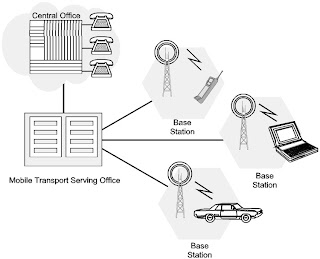The
demand for affordable, fast data connections is increasing both in
the United States and around the globe. There are several reasons why
faster connections are not readily available and affordable. They are
a complex mix of entrenched interests of the incumbent connection
providers, the high costs of wireline upgrades and the associated
slow pace, cumbersome regulations, and tariffs; and the difficulty of
forcing more data through already crowded data pipes.
A
new wireless broadband point-to-multipoint microwave technology
called local multipoint distribution service (LMDS) stands ready to
bypass those barriers to readily available broadband connections. In
the United States, incumbent connection providers were prevented from
owning or controlling the large block of LMDS microwave spectrum in
their territory for a period of 36 months (from the auction);
consequently, the chances of entrenched interests limiting bandwidth
availability are small. In Canada, local multipoint communication
service (LMCS) applications from entrenched landline providers were
not accepted (see sidebar, "More Communication Choices for
Canadians"). The 1 GHz of LMCS spectrum was awarded to newly
established companies and consortiums.
LMDS
is a wireless broadband service and consequently does not require
landline wire upgrades, which makes it affordable when compared with
landline technologies. And LMDS is lightly regulated and can be used
for two-way transmission of voice, video, and data. Finally, the LMDS
spectrum is immense. This large amount of radiofrequency (rf)
spectrum allows operators to realize data rates above 1 billion bits
per second (bps).
LMDS
also provides high-capacity point-to-multipoint data access that is
less investment-intensive. LMDS, with its wireless broadband
delivery, combined with the significant amount of spectrum allocated,
allows for a very high quality communications services. It transmits
milliwave signals within small cells. Since it has been tested by the
U.S. military and corporate pioneers like SpeedUs.com, Inc., it is
undoubtedly a proven technology.
The
key to business and consumer acceptance of LMDS as an attractive
solution is the affordability and availability of the systems.
Because of its point-to-multipoint nature, one LMDS cell with a
single hub transceiver can serve hundreds or thousands of
simultaneous customers. The affordability of the overall LMDS
solution is therefore largely dependent on the cost of the customer
premises equipment.
Internationally,
governments are working quickly to enable the use of high-gigahertz
microwave spectrum for wireless broadband data, voice, and video
transport. In many ways, the opportunities internationally are
greater than those domestically because of the poor state of the
communications infrastructure internationally and the desire of the
ministries of telecommunications to move rapidly to make their
systems competitive with those in the United States.
LMDS
Advantages
• Ease
and speed of deployment
• Fast
realization of revenue
• Easy
network management
• Large
bandwidth
• Small
cell size
LMDS
Disadvantages
• Requires
Line of Sight
• Affected
by rain, foliage and reflections
• Many
cell sites are required
• Multiple
cell sites cause interference
• Security
concerns
MMDS
stands for Mutlichannel Multipoint Distribution Service and this is
most commonly termed as Wireless Cable. MMDS is really a wireless
communications technology which can be used in high speed networking
within the telecoms market. It is frequently utilized rather than a
programming reception involving cable connection and is also most
favored in India, Brazil, Australia, Pakistan, america, Barbados,
Mexico, Russia, Belarus, Lebanon and various areas. Throughout these
locations it is primarily used in non-urban parts which happen to
have sparse population. This really is caused by a defieicency of
regular use cables. Thats usually where laying wires is most popular
subsequently MMDS assistance are usually accessible.
MMDS
is specified by means of UHF or ultra-high-frequency communications.
It operates inside the given FCC accredited frequency. In the usa the
FCC is split up into Basic Trading Areas or BTA's which inturn sell
the right to transfer MMDS in areas where service providers can be
obtained.
MMDS
uses BRS bands of 2.1 GHz and also from 2.5 GHz to 2.7 GHz microwave
frequencies. Rooftop microwave antennas are widely used to pass on
data indicators and also BRS-delivered television reception. Antennas
are attached to a transceiver or down-converter which in turn obtains
and transmits microwaves signals. They're afterward converted to the
frequencies which can be compatible with TV tuners. This is similar
to the way indicators are transformed into the frequencies for
satellite dishes but instead these are suitable for TV coaxial
cables.
The
MMDS band is afterward segregated into channels of 33 6 MHz. Because
of this these kinds of people can own a number of other channels,
radio, multiplex televisions along with Internet data. Digital cable
channels are then capable of regulate 64QAM as well as 30.34 Mbps
together with 256QAM modulation having 42.88 Mbps.
MMDS
Disadvantages
• Limited
two way capabilities (upstream bandwidth is limited)
• Shadowing
and interference prevents ubiquitous coverage
• Normal
radio security concerns
MMDS
vs. LMDS
- Supports high bandwidths but gets affected byrain, foliage and reflections
- Requires Line of Sight conditions to serve
- Operates in smaller radius and hence morenumber of cell sites required for a city coverage
- Supports relatively lower bandwidths but doesnot get affected by the rain or foliage conditions
- Also works in Near Line of Sight (NLoS)conditions
- Supports larger coverage area hence few cellsites required to cover a city
Originally
designed for wireless digital television transmission, LMDS and
multipoint microwave distribution system (MMDS) were predicted to
serve wireless broadband subscription television needs. MMDS is also
a broadband wireless communications service that operates at lower
frequencies. Usually, LMDS operates at frequencies above the 10-GHz
range and MMDS at frequencies below the 10-GHz range. Later on they
were extended to offer other interactive services.
Sources:
http://www.networkcomputing.com/netdesign/bb3.html
http://www.eetimes.com/electronics-news/4039196/LMDS-MMDS-race-for-low-cost-implementation
http://www.networkcomputing.com/netdesign/1223wireless1.html
http://quantumwimax.com/index.php?page=History-of-Wimax
broadband
telecommunications handbook





